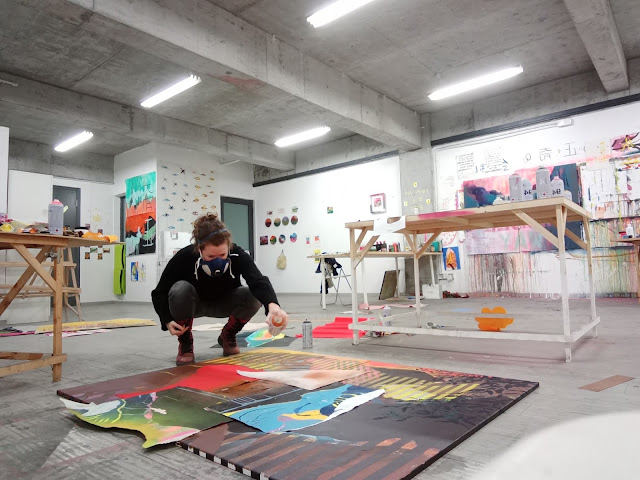DAC Solo Exhibition Opening
a thread, a rip, a seed
一个线程,一个裂口,一个种子
A
thread binds us together; A rip in the
fabric of reality allows for a seed of
understanding
Where
do stripes conceal and where do stripes reveal?
Painting becomes a method of seeing:
How much can I see, how much do
I miss?
Remaining open to complexity; recognising difference; working with
rather than against limitations; perceiving things differently; acknowledgement
of the unknown, partiality or incompleteness.
After a year and a half of living in China, my work here as
artist/ researcher/ teacher is presently culminating in a solo exhibition at
the DAC, Dimensions Art Centre, in Chongqing
city centre, in a few weeks time. A community-run arts and research space, run by SFAI intermedia
lecturer and director Mr Zeng Tu, the DAC invites international artists,
curators and designers from all over the world to participate in their
residency programmes, providing on-site accommodation and work engagement and
presentation opportunities with the local community. You can find out more
about their work here!
Detail from ‘Pearl Lake at Simian Shan’, Acrylic on canvas, 160cm
x 80cm
The exhibition will contain a series of paintings, drawings, scrolls and objects that I have made in response to my time here. The mountains in and around the city of
Chongqing in particular have become the medium through which notions of place, language, culture and human
connection found an anchor in my work. Explorations in painterly
means of concealing and revealing, imprinting and stripping away and altering
and obstructing my subject matter have
thus become metaphors for acknowledging and attempting to dismantle the prisms,
blockades and impediments that often exist in cross-cultural dialogue.
At work in Huxi Commune Studios, Chongqing
When walking in these mountains, I felt truly connected to the people I met, to the history and culture of China, and
to the land and ideals of the country itself. The elemental power of nature enables humans to transcend language, politics and culture: human differences and cultural/ linguistic
boundaries disappear and constructs which normally narrow our vision fall away.
The act of walking, of allowing my feet to lead me as the landscape unfolds before my eyes, also aligned itself well to the
process of allowing my materials to lead me in the studio. I could venture
down different paths on both journeys, altering routes to allow for internal
and external conditions. A small, quiet, repetitive step or gesture (such as
the winding of thread) when I felt sluggish and slow, and unable to
connect with the vibrant decisiveness that creativity often demands; the
strongest, boldest strides or brushstrokes and throwing around of paint, when
inspiration surges and I am invigorated by breath and action.
Near the Tibetan Labrang Monastery, Xiahe, Gansu Province
View of the mountains at Simian Shan, Chongqing Province
‘Spirit Encounter’, Gouache and
ink on paper, 15cm x 10cm
The mountain came to represent a spiritual portal to opening the heart,
opening the eye, opening the mind. This portal only opens when the obstructions
that prevent one from seeing clearly disappear. Often, many paths that lead to
knowledge/ understanding/ connection/ wisdom remain hidden and concealed, and
so objects such as lamps, glasses and mirrors, which alter, help or distort our
vision become symbolic in my work. In Buddhism, the mirror too is a potent
symbol, explained by Peter Matthiessen in his wonderful book The Snow Leopard:
“The reflection is neither inside or outside of the
mirror, and thus things are freed from their ‘thing-ness’, their isolation,
without being deprived of their form; they are divested of their materiality
without being dissolved. This is part of the mirror teaching from the Atavamsaka
Sutra, attributed to
Nagarjuna, an Indian sage of the 1st Century A.D who is also
credited with the compilation of the Prajna Paramita Sutra, the fundamental
text of Mahayana Buddhism.”
找
到 中
间 地带
zhǎo dào zhōng jiān dì dài
zhǎo dào zhōng jiān dì dài
Find the middle ground
In Buddhism sutras, the Middle Way is known as the first of the Buddha’s
teachings following his enlightenment and refers to the teaching of living
without extreme views and practices. This belongs to the Noble Eightfold Path, a
series of precepts on living in peace and equanimity with fellow beings. The Middle Way also speaks of the emptiness,
or void, between existence and annihilation, and is essentially a manner of
freeing oneself from maintaining one-sided perspectives and polarising opinions
that arise through illusion.
IFAD student at work
Similarly, finding a middle ground between different cultures,
linguistic differences and cultural expectations has been key to the process of
learning on all sides. I feel I’m learning just as much as my students, and
this remains vital for a dynamic, reflective educational environment. In Rita
Irwin’s conceptualisation of A/R/Tography, she summarises the practices of Artist/ Researcher/ Teacher, which I believe are intrinsically interconnected:
“Art is the visual reorganisation of experience that
renders complex the apparently simple or simplifies the apparently complex.
Research is the enhancement of meaning revealed through ongoing interpretations
of complex relationships that are continually created, recreated and
transformed. Teaching is performative knowledge/ knowing in meaningful
relationships with learners.”
IFAD and IPMAD students engaged in discussion at the SFAI gallery
Currently, students over here are in the middle of hearing back from various institutions
about their applications to study art and design in the UK, and are excitedly
looking forward to their year or years abroad. Lives connect, knowledge is transmitted,
and the ripples spread. Meanwhile, my exhibition, a
thread, a rip, a seed opens here on Saturday 27th April, and
I’ll be posting its progress on here, my Facebook page and on Instagram
(@ginnyelston). To end, here’s another lovely quote from Rita Irwin:
“Living a life of deep meaning through perceptual
practices that reveal what was once hidden, create what has never been known,
and imagine what we hope to achieve.”











Comments
Post a Comment